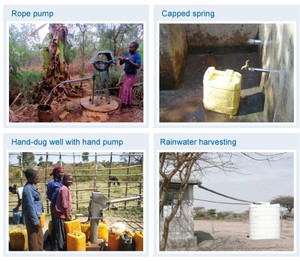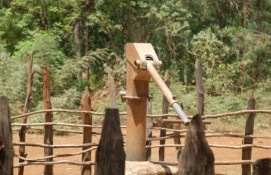Plans for rural water supply
Rural water supply plans in the OWNP are detailed and complex and clearly illustrate the size and scale of the Programme.
Rural water supply – new construction
Plans for new rural water schemes were developed using several different types and sources of data. In addition to the population and water source information mentioned above, they also considered the range of water supply technologies available, the number of people each could serve, and their service life (how many years each was expected to last). The type of scheme and number for each region depended on the size of geographical area, population and potential source of water. This complex process resulted in plans to create nearly 100,000 new rural water supply schemes across Ethiopia in order to achieve 100% access, of which more than 40,000 are self-supply schemes at household or community level.
Do you recall from Study Session 13, roughly how many of these planned new schemes for rural water supply are self-supply schemes?
According to the extract from the results framework in Table 13.1, more than 42,000 self-supply water facilities are planned.
The regional distribution and the range of different technologies to be constructed are shown in Table 14.1. Table 14.2 shows how many people were expected to benefit from each of the potential technologies considered. You can see illustrations of a few of these technologies in Figure 14.1.
Table 14.1 New rural water supply facilities by region and type of scheme. (Note: The figures in columns and rows in this table do not add up to the totals shown but are as published in the OWNP document.) (OWNP, 2013)
| Region |
Household-dug well with rope pump |
Community-dug well with rope pump |
Dug well with hand pump | Capped spring | Spring with piped system |
Shallow borehole with hand pump |
Shallow borehole with submersible pump |
Deep borehole with piped scheme |
Multi-village scheme | Rainwater harvesting | Cistern | Hafir dam | Total | |
| Tigray | – | – | 947 | 185 | – | 785 | 186 | 138 | 1 | – | – | – | 2242 | |
| Gambella | – | 101 | 268 | 87 | – | 237 | 6 | 4 | – | – | – | – | 702 | |
| B. Gumuz | – | – | 711 | 309 | – | 414 | 22 | 20 | – | – | – | – | 1,476 | |
| Dire Dawa | – | – | – | – | – | 32 | 5 | 3 | – | – | – | – | 41 | |
| Harari | – | – | – | – | – | 7 | 4 | 1 | 0 | 30 | – | – | 42 | |
| Somali | – | – | – | – | – | – | 35 | 88 | 2 | 244 | 1397 | 879 | 2645 | |
| Amhara | 7088 | 9479 | 8068 | 1724 | 17 | 2718 | 326 | 135 | – | – | – | – | 29,555 | |
| Afar | – | – | – | – | – | 267 | 27 | 51 | – | 475 | 670 | – | 1491 | |
| SNNPR | 1299 | 1955 | 4438 | 4588 | 143 | 2640 | 684 | 356 | – | 1467 | – | – | 17,571 | |
| Oromia | 8724 | 13,959 | 9785 | 5145 | 51 | 3681 | 805 | 479 | – | – | – | – | 42,628 | |
| Total | 17,034 | 25,495 | 24,217 | 12,037 | 211 | 10,781 | 2076 | 1275 | 4 | 2216 | 2067 | 879 | 98,393 |

Figure 14.1 Examples of water supply schemes from Tables 14.1 and 14.2.
Table 14.2 Estimated beneficiaries by type of scheme. (OWNP, 2013)
| Household-dug well with rope pump | 6 |
| Community-dug well with rope pump | 75 |
| Dug well with hand pump | 270 |
| Capped spring | 350 |
| Spring with piped system | 4000 |
| Shallow borehole with hand pump | 500 |
| Shallow borehole with submersible pump | 1500 |
| Deep borehole with piped scheme | 3500 |
| Multi-village scheme | 5000 |
| Rainwater harvesting | 100 |
| Cistern | 100 |
| Hafir dam | 500 |
| Other | 800 |
Based on the data in Tables 14.1 and 14.2, approximately how many people in the Harari region are expected to benefit from shallow boreholes with submersible pumps and how many from rainwater harvesting schemes?
In the Harari region, the estimates are that 4 shallow boreholes with submersible pumps will serve 4 × 1500 = 3000 people and 30 rainwater harvesting schemes will serve 30 × 100 = 3000 people.
Rural water supply - rehabilitation
Rehabilitation means restoring a non-functional water scheme to an efficient working condition by repair or construction methods. The reasons for the non-functionality of water schemes include poor selection of site, poor design and construction, and poor operation systems. Figure 14.2 shows an example of a water scheme in need of rehabilitation. The OWNP plans to rehabilitate 20,010 non-functional water supply schemes in order to achieve the target of reducing non-functionality to 10% of the total number of schemes.
If a rural water scheme managed under the CMP approach becomes non-functional, who is responsible for repairing it?
As a community-managed project, the WASHCO would be responsible for maintaining and repairing the scheme in collaboration with the Woreda WASH Team.

Figure 14.2 A non-functional hand-dug well. Only 2000 birr was needed to repair the pump.
Rural water supply – financial requirement
In the list of six planning questions that you read in Section 14.1, the last is ‘how much?’ Estimates for the financial requirement included programme management, study and design, post-construction support, capacity building, water quality monitoring, catchment management, and environmental safeguards were all determined, in addition to construction and rehabilitation of water supplies for households, schools and facilities. For rural water supply, the financial requirement was estimated at a total of more than US$ 1.13 billion.